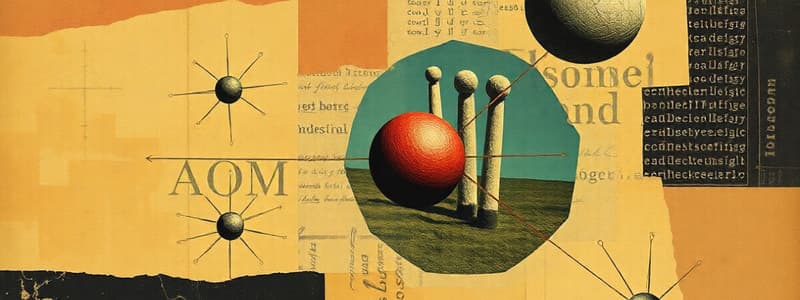Podcast
Questions and Answers
Which of the following scientists provided evidence for the existence of electrons?
Which of the following scientists provided evidence for the existence of electrons?
- John Dalton
- Democritus
- J.J. Thomson (correct)
- Ernest Rutherford
Which model proposed that atoms are spheres of positive charge with electrons embedded within?
Which model proposed that atoms are spheres of positive charge with electrons embedded within?
- Bohr Model
- Plum Pudding Model (correct)
- Nuclear Model
- Dalton's Model
What experimental evidence led Rutherford to propose his Nuclear Model?
What experimental evidence led Rutherford to propose his Nuclear Model?
- The observation of most alpha particles passing through a gold sheet
- The deflection of some alpha particles by the gold sheet (correct)
- The observation of electrons orbiting the nucleus in specific shells
- The discovery of neutrons
What did Bohr's model address that was a flaw in Rutherford's Nuclear Model?
What did Bohr's model address that was a flaw in Rutherford's Nuclear Model?
Which of these scientists focused on the composition of the nucleus?
Which of these scientists focused on the composition of the nucleus?
Flashcards
Atomic Theory
Atomic Theory
The theory that everything is made of tiny, indivisible particles called atoms.
Plum Pudding Model
Plum Pudding Model
J.J. Thomson's model describing atoms as spheres of positive charge with electrons embedded in them.
Rutherford's Nuclear Model
Rutherford's Nuclear Model
Model proposing that atoms have a compact nucleus with positive charge and electrons orbiting around it.
Bohr Model
Bohr Model
Signup and view all the flashcards
Discovery of Neutrons
Discovery of Neutrons
Signup and view all the flashcards
Study Notes
Atomic Theory
- Democritus (500 BC) proposed the idea that everything is made up of tiny, indivisible particles called atoms, separated by empty space.
- John Dalton (1800s) improved on Democritus's ideas, describing atoms as solid spheres and suggesting that different types of atoms compose different elements.
Plum Pudding Model
- J.J. Thomson (1897) conducted experiments showing atoms are not solid spheres, proving the existence of negatively charged particles, now known as electrons.
- He proposed the Plum Pudding Model, suggesting atoms are spheres of positive charge with electrons embedded within.
Rutherford's Nuclear Model
- Ernest Rutherford (1909) and his students fired positively charged alpha particles at a thin gold sheet to study atomic structure.
- Most alpha particles passed through the gold, but some were deflected, contradicting Thomson's Plum Pudding Model.
- Rutherford proposed the Nuclear Model, suggesting a compact nucleus containing all positive charge and a cloud of negative electrons orbiting it.
Bohr Model
- Niels Bohr (1913) addressed a flaw in Rutherford's model, suggesting electrons orbit the nucleus in specific shells, preventing the atom from collapsing.
Further Discoveries
- Rutherford later discovered the positive charge in the nucleus is made up of small, discrete particles called protons.
- James Chadwick (1932) provided evidence for neutral particles in the nucleus, now known as neutrons.
Studying That Suits You
Use AI to generate personalized quizzes and flashcards to suit your learning preferences.




